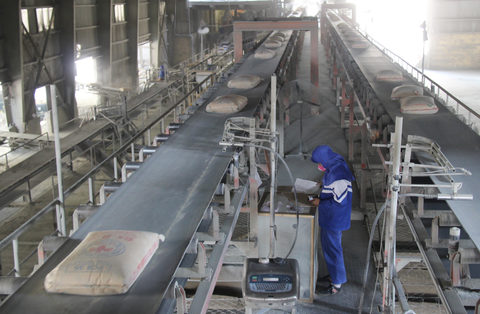Tax code bogs down exports: VN cement firms
 |
| Inside a La Hien Cement Joint Stock Company factory. Local cement producers voiced concerns over competition with VAT free imports.-VNA/VNS Photo Hoang Nguyen |
Tran Viet Thang, general director of the Viet Nam Cement Industry Corporation (VICEM), said the increasing input material and fluctuating foreign exchange rate have brought difficulties for cement exporters.
“Vietnamese cement has been under pressure both in terms of price and supply in comparison with China, Thailand, Indonesia and Japan in the region,” Thang said, adding that these factors could directly affect domestic cement production.
He said the Government’s Decree No 100/2016/ND-CP stipulates that exported cement products are not eligible to enjoy input value-added tax (VAT). In addition, the product is imposed 5 per cent export tax.
The taxes have made the export cost increase by US$4.5 per tonne of clinker and $7.5 per tonne of cement based on average Free-on-board (FOB) prices of $30 and $50 respectively.
Nguyen Quang Cung, chairman of Viet Nam Cement Association, said the cement export amount last year was reduced by 5.9 per cent from the previous year.
Notably, since the middle of 2016, the cement export prices were reduced by around $10 per tonne from the end of 2015.
“Many cement producers could face risks of halting their production or bankruptcy if the Government does not create timely solutions to unknot these difficulties,” Cung said.
He added that members of Southeast Asian Cement Association in a meeting in October voiced that the tax policies could reduce Viet Nam’s cement competitiveness in the international market.
Lawyer Le Dinh Vinh, director of Vietthink Law Firm, said VAT and export tax have been indirect taxes imposed on the consumers.
“If we impose a high export tax, purchasing power will be reduced,” Vinh said.
The Government has enhanced collection of direct taxes and reduced indirect taxes, a move that has been suitable with the world’s trend and the country’s reality.
Increasing export tax has been considered against the Government’s guidelines.
Viet Nam set an annual export target of 20-35 per cent of the country’s total cement and clinker capacity by the year of 2030.
Viet Nam’s cement output is expected to reach 120-130 million tonnes a year by 2020, while local consumption was estimated at 93 million tonnes, making a possible redundancy of around 25 to 35 million tonnes.
By the end of last year, the cement industry’s total designed capacity reached 88 million tonnes a year.
However, some cement projects which are expected to become operational in 2018 would bring the country’s total designed capacity to 108 million tonnes a year.
Last year, cement and clinker exports were over 14.73 million tonnes or $561 million, reducing 7.1 per cent and 16 per cent in terms of quantity and value respectively from the previous year. Philippines and Bangladesh have been Viet Nam’s two largest cement importers.
What the stars mean:
★ Poor ★ ★ Promising ★★★ Good ★★★★ Very good ★★★★★ Exceptional
Latest News
More News
- Double-digit GDP growth within reach with shift to higher-value expansion (January 06, 2026 | 08:33)
- Takeda Vietnam awarded for ongoing support of Vietnam’s sustainability efforts (December 31, 2025 | 21:00)
- Vietnam's retail market tops $269 billion in 2025 amid e-commerce boom (December 31, 2025 | 19:00)
- Stronger legal framework urged as trade fraud surges online (December 31, 2025 | 18:58)
- FPT exports first chip shipment to Japan (December 31, 2025 | 10:47)
- AkzoNobel rolls out sustainability campaign “It All Adds Up” for the wood sector (December 31, 2025 | 09:23)
- Textile apparel firms deliver robust earnings despite global tariff pressures (December 30, 2025 | 10:09)
- Businesses ramp up production as year-end orders surge (December 30, 2025 | 10:05)
- Vietjet chairwoman awarded Labour Hero title (December 29, 2025 | 13:06)
- How to unlock ESG value through green innovation (December 29, 2025 | 10:03)















 Mobile Version
Mobile Version